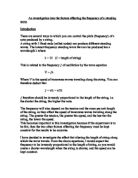This point leads on to the factors involved with reducing the wave energy before it actually reaches the coastline. If the near shore is shallow, with a very long, gentle gradient, then waves are more likely to break further out to sea. This is because the point at which wave height is equal to water depth is reached further from the coastline. This line is called the plunge line. When the wave breaks, energy is used and the remaining energy begins to dissipate on approach to the beach. Therefore, the further the plunge line from the coastline, the less wave energy there is that reaches it, as there is a greater distance over which the wave energy can dissipate. An example of such a coastline is that of northeast Anglesey in Wales.
If there is not a gently sloping near shore profile, then the plunge line will occur closer to the coastline. If the coastline is simply a cliff face, then the plunge line may not occur at all. In this case, very little of the wave energy is dissipated, so almost all of it arrives at the coastline. This results in the process of wave pounding, in which a wave hits the cliff with all its energy, creating a shockwave of up to thirty tonnes per square metre. An example of such a coastline is that of Holderness during high tide.
There are other factors involved in reducing the energy reaching the coastline, for example, the types of sediment with which the near shore zone consists. The rougher the seabed, the more frictional drag and the less energy that reaches the coastline. Different types of sediment dissipate wave energy to different degrees. As the sediment is determined by long shore drift and rock type etc, these in turn are factors themselves. Other forms of offshore topography, like corals or kelp forests, influence the wave energy in a similar way. An example of a coral reef is the Great Barrier Reef of northeast Australia. Kelp forests are common in the shallow waters off Florida.
The shape or features of the coastline itself influences the wave energy both positively and negatively. At estuaries, two opposite flows meet, (one from rivers and one from the sea current.) This conflict of energy direction causes load deposition, which can act as a buffer zone to the main coastline, (e.g. Orford Ness, Sussex). While this feature may decrease wave energy, other shapes of the coastline may funnel the wave energy, concentrating the amount that meets the coastline. An example of this is wave refraction, in which the wave energy is “bent” around a headland, concentrating the wave energy on the headland. Consequently, the surrounding coastline is only met with weak wave energy. An example of where this occurs is Flamborough Head, Yorkshire.
A different kind of influencing factor is wind direction. It influences the angle at which the wave hits the beach. The more oblique the approach, the larger the distance the wave has to travel over the seabed of the near shore. This will mean longer contact with it, resulting in greater total frictional drag and less wave energy arriving at the coastline. Also, an oblique approach results in long shore currents, which cause long shore drift. This could supply sediment to increase frictional drag in specific areas, for example, split formation.
The final major factor is human influence. It has positive and negative effects. The removal bed material from one stretch of coastline will increase the amount of wave energy reaching it. However, at the coastline where the material is deposited, the reverse will occur. Sea walls, like those lining the coastline of the Netherlands, are often the major form of sea defence employed to protect coastal settlements from sea erosion. These can have the effects of cliffs, in which maximum wave energy is delivered. The resulting wave pounding has caused the need for sea walls to be replaced every twenty-five years. Other forms of coastal defence, such as groynes, such as those at Southwold, Suffolk, can result in reducing the wave energy. They trap long shore drift material, giving the near shore a longer, less steep gradient, which helps to dissipate wave energy.
The elements discussed in the essays combined together, sum up well the factors, which influence the amount of wave energy, which arrives at a coastline. However, it only accounts for the ordinary, day to day factors. Sometimes in history, there have been exceptional influencing factors, for example, the North Sea storm surge of 1953. It was caused by extremely low pressure, which enabled the water of the North Sea to pond. As it moved south, the energy was funnelled by the coastline, causing six metre high waves. There are many other geographical events, which have similar results. Volcanoes like Krakatoa cause huge Tsunamis. When it erupted in 1883 it caused a wave of 300 feet high killing 3600 people. Earthquakes in the waters off Japan like that of 1896 have caused waves of 100 feet high killing 22072. 7000 years ago a landslide occurred off the coast of Norway causing a wave 1000 feet high! Finally meteor collisions with the earth cause waves bordering on the apocalyptic like the impact, which occurred 65 million years ago. Although rare, such waves exert such phenomenal energy on the coastline that such events are a very important factor indeed.









